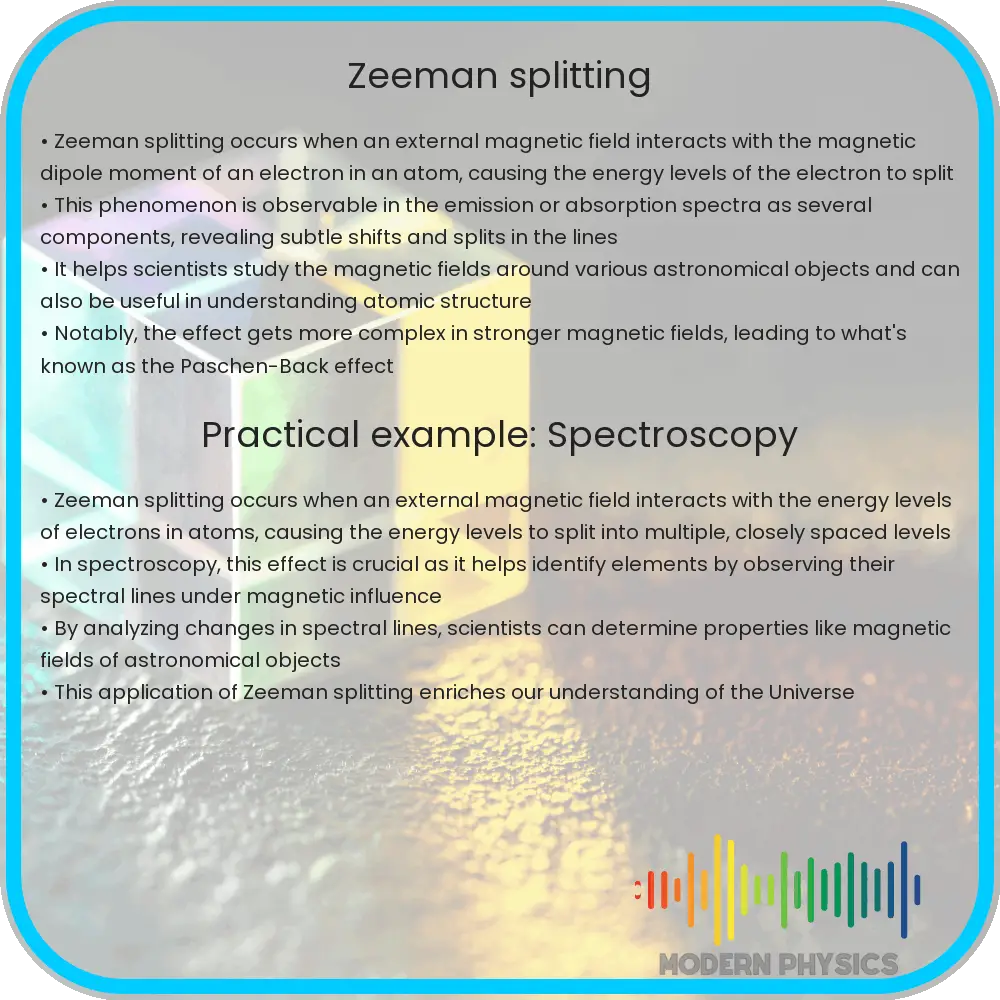Explore Zeeman Splitting: its principles, applications in science and tech, and analysis methods. Unlock the secrets of magnetic spectral lines.

Understanding Zeeman Splitting: A Comprehensive Overview
The phenomenon of Zeeman Splitting is a cornerstone in the field of spectroscopy and quantum physics. First discovered by Pieter Zeeman in 1896, this effect occurs when an external magnetic field is applied to atomic or molecular spectral lines, causing them to split into multiple components. This intriguing physical concept has significant implications in various scientific fields, ranging from astrophysics to material science.
Principle of Zeeman Splitting
At its core, Zeeman Splitting is an outcome of the interaction between magnetic fields and the magnetic moments of electrons within an atom. In the absence of a magnetic field, the energy levels of electrons are degenerate – meaning they have the same energy. However, when exposed to a magnetic field, these levels split into different energy states. This splitting is a direct consequence of the Lorentz force acting on the moving electrons, altering their energy states based on their magnetic orientation relative to the field.
The degree of splitting is governed by the Zeeman effect equation:
- ΔE = μBgJBmJ
Here, ΔE represents the energy difference between the split levels, μB is the Bohr magneton, gJ is the Landé g-factor, B is the magnetic field strength, and mJ is the magnetic quantum number.
Applications of Zeeman Splitting
The practical applications of Zeeman Splitting are vast and diverse. In astrophysics, it aids in understanding the magnetic fields of celestial bodies like stars and galaxies. The effect is particularly crucial in solar physics, where it helps in measuring the Sun’s magnetic field, contributing significantly to our understanding of solar phenomena like sunspots and flares.
In the realm of chemistry and material science, Zeeman Splitting is essential for analyzing the composition and properties of various substances. Through Magnetic Resonance Spectroscopy, it enables the precise determination of electronic structures, bonding patterns, and molecular geometries.
Moreover, in the field of nuclear and atomic physics, Zeeman Splitting has been instrumental in verifying quantum mechanics theories and understanding the fine structure of atomic spectra.
Aside from these, this phenomenon finds application in various technological fields such as optical pumping, laser cooling, and in the development of high-precision instruments like atomic clocks and magnetometers.
Analysis of Zeeman Splitting
Analyzing the Zeeman effect involves observing the spectral lines under the influence of a magnetic field. The pattern of splitting – whether into two, three, or more lines – and the spacing between these lines provide critical information about the magnetic properties and internal structure of the atom or molecule in question. Advanced techniques such as Laser Induced Fluorescence (LIF) and Electron Paramagnetic Resonance (EPR) are often employed to achieve high-resolution observations.
The analysis of this splitting not only sheds light on the fundamental properties of matter but also paves the way for new discoveries and innovations in various scientific fields.
Detailed Analysis Techniques in Zeeman Splitting
To delve deeper into the intricacies of Zeeman Splitting, sophisticated analytical techniques are employed. High-resolution spectroscopy is a primary tool, enabling scientists to observe minute differences in the energy levels. This involves the use of spectrometers capable of detecting changes in wavelength as small as one part in a billion. Such precision is crucial for observing the splitting patterns in different elements and under varying magnetic field strengths.
Another critical method is Polarization spectroscopy. Since the Zeeman effect often results in polarized light – with each split component having a specific polarization state (circular or linear) – analyzing the polarization of light provides valuable information about the magnetic field and the quantum states of the electrons.
Challenges and Future Directions
While Zeeman Splitting offers a wealth of information, it also poses significant challenges. One of the major hurdles is the requirement of strong and stable magnetic fields, especially for observing fine and hyperfine splitting. Additionally, the interpretation of results can be complex, particularly in systems with multiple overlapping effects, like the Stark effect (splitting in electric fields).
Future research in this area is directed towards enhancing the sensitivity and resolution of measurement techniques. This includes the development of more advanced lasers and detectors, as well as computational methods for better data analysis and interpretation.
There’s also a growing interest in studying the Zeeman effect under extreme conditions, such as very high magnetic fields or ultra-cold temperatures, which could lead to novel quantum phenomena and deeper insights into the fundamental laws of physics.
Conclusion
Zeman Splitting, a phenomenon critical in the field of spectroscopy and quantum physics, has far-reaching implications and applications. From helping us understand celestial phenomena to aiding in the development of cutting-edge technologies, its influence is pervasive across multiple scientific disciplines. The future of Zeeman Splitting research holds great promise, offering potential breakthroughs in our understanding of the quantum world and paving the way for technological innovations. As we continue to refine our techniques and push the boundaries of our knowledge, the Zeeman effect will undoubtedly remain a key player in the unfolding story of scientific discovery.
